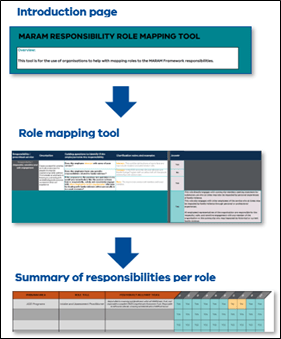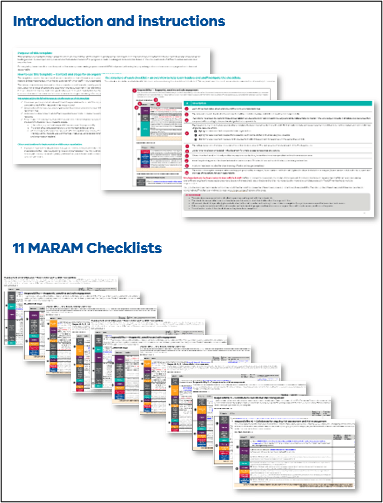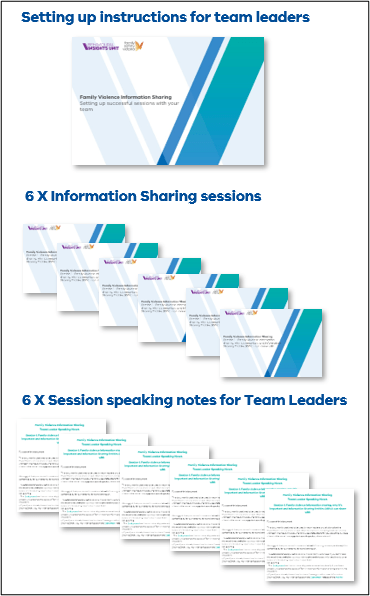The Family Violence Multi-Agency Risk Assessment and Management (MARAM) Framework ensures services are effectively identifying, assessing and managing family violence risk. We developed it following the Royal Commission into Family Violence and other reviews.
The behavioural challenge
Alcohol and other drug (AOD) organisations were required to align their practices with the MARAM Framework to support people experiencing family violence.
However, adopting a new practice is hard as staff have well-established habits that need changing. The Framework is complex and detailed, which can be difficult to get across, especially when you don’t have a lot of spare time.
What we did
- We conducted workshops and interviews with AOD organisations to understand the range of barriers and challenges to implementing the MARAM Framework.
- Based on the findings from this research, we developed prototype support tools while engaging with and getting feedback from:
- the collaborating AOD organisation
- the Victorian Alcohol and Drug Association (VAADA)
- Family Safety Victoria (FSV).
- Where possible, we asked the AOD organisations to get relevant staff members to test the tools. So that they were user friendly and helped meet the intended needs.
What we developed
We produced three tools to support AOD organisations to use MARAM:
- A MARAM responsibility role mapping tool
- MARAM responsibility capability checklists
- A series of family violence information sharing team learning sessions
Tool 1: A MARAM responsibility role mapping tool
This allowed AOD organisational leaders to help understand which staff in their organisation had which of the 10 MARAM responsibilities.
The principles underpinning this tool included:
- reducing friction cost
- reducing cognitive load
- making it easy.
Reducing friction cost
Previously, organisations had to refer to separate documents for guidance on mapping MARAM responsibilities and recording them. This brings together those two components into one place, reducing friction costs involved in navigating between documents.
Reducing cognitive load
Using yes/no questions and automated logic means the person completing this tool does not need to know the MARAM policy in depth.
Making it easy
We've incorporated prompts into the tool. This ensures there are instructions at the right points.
Tool 2: MARAM responsibility capability checklists
These were practical tools that made it easy to understand what actions you could complete when building capability in a particular MARAM responsibility. We designed the checklists for team leaders and frontline staff to use when they had identified MARAM responsibilities.
The principles underpinning this tool included:
- calls to action
- segmentation
- commitment devices.
Calls to action
It helps to frame each item as a call to action by presenting the resources as a checklist with accompanying actions. Calls to action help people to complete behaviours as they present a clear direction on what the right behaviour is.
Segmentation
The checklists collectively contain many resources. To help people make sense of this information, we've segmented the checklists into various logical groups. For example, we've categorised resources in ways that show if it is an organisational, sector or FSV resource. We also categorised them depending on the type of resource it is, such as practice guidance, policy, training, networks, practical tools or support for team / organisational leaders.
Commitment devices
When people commit to an action and know that someone else is aware and monitoring that commitment, they are more likely to complete the task. Using this behavioural insight, the checklists include a space for team leaders to sign off as well as space for individuals to commit to and mark off actions as they are completed.
Tool 3: A series of family violence information sharing team learning sessions
These sessions helped build the knowledge and confidence of both team leaders and frontline staff to implement information sharing requirements in practice.
The principles underpinning this tool include:
- segmentation
- social learning
- simplification.
Segmentation
Sessions are chunked into small consumable segments to help people to absorb large amounts of information over a number of sessions without feeling overwhelmed.
Social learning
The sessions have been developed with a strong focus on practical application and sharing experiences between peers. This acts as a commitment device for people to share with one another, drives ownership in their own learning and develops connections for future information sharing development.
Simplification
Presentation content has been designed with a minimalistic style to support people not to feel overwhelmed with information. This content has been complemented with in depth speaking notes that team leaders can use to elaborate on the simplified slide content.
We evaluated the design and limitations of the tools and provided recommendations for future use.
These resources are so much easier to read, absorb and follow - I really appreciate the work the BIU have done with our collective feedback.
What's next?
We provided several recommendations to FSV about implementing the tools more broadly. In a follow-up survey of FSV employees, a majority of respondents said that the responsibility mapping tool was either somewhat or highly useful to them (the other tools were not part of the survey).
Thanks
We thank our partners at Family Safety Victoria (FSV) and the two AOD services that participated in the pilot stages of this project.
Updated


